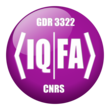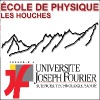![]() Scientific Direction:
Scientific Direction:
- Claude Fabre (Laboratoire Kastler Brossel, Université Pierre et Marie Curie, Paris, France);
- Vahid Sandoghdar (Max Planck Institute for the Science of Light, Erlangen, Germany);
- Nicolas Treps (Laboratoire Kastler Brossel, Université Pierre et Marie Curie, Paris, France).
![]() Long Lectures:
Long Lectures:
- Stephen Barnett (Strathclyde University, Glasgow): Basics of quantum information;
- Philippe Grangier (IOGS, Palaiseau): Quantum optics with continuous variables;
- Jean-Jacques Greffet (IOGS, Palaiseau): Basics of near-field optics and plasmonics;
- Jeffrey Kimble (Caltech, Pasadena): Basics of cavity QED and quantum networks, CQED with trapped atoms;
- Astrid Lambrecht (LKB, Paris): Casimir Forces;
- Ulf Leonhardt (University of Saint Andrews): Metamaterials;
- Gerd Leuchs (MPI - Erlangen): Basics of Quantum Optics;
- Mikhail Lukin (Harvard University): Quantum effects in atomic ensembles and NV centers;
- Michel Orrit (Leiden University): Single molecule optics;
- Oskar Painter (Caltech, Pasadena): Nanofabrication, photonic crystals, optomechanics;
- Aephraim Steinberg (University of Toronto): Quantum Measurements;
- Jelena Vukovic (Stanford University): Quantum Optics of quantum dots.
![]() Short Courses:
Short Courses:
Around 15 seminars will complement the long lectures, and will be announced soon.
![]() Scientific Program:
Scientific Program:
Quantum optics is one of the best test benches for exploring the strangeness of the quantum world and has put forth potential applications to the domains of information and metrology. The field of nano-optics has also recently emerged, boosted by the development of nanoscience, covering topics such as near-field optics, single-molecule microscopy, nano-antennas, plasmonics and metamaterials. These two domains naturally meet at the small length scales, where one gradually passes from classical physics to quantum physics. Phenomena such as the Casimir effect, ground-state cooling of mechanical oscillators, and plasmonic modification of the molecular radiation are some examples of the cross roads that have attracted interest. The aim of this school is to bring experts of these fields together with a new generation of physicists, and to trigger fruitful discussions between different communities.
![]() Registration:
Registration:
Applications must reach the School before March 15, 2013 in order to be considered by the selection committee. Application form can be found here. The full cost per participant, including housing, meals and the book of lecture notes, is 1500 euros. Thanks to financial support by various funding agencies, we expect to cover part of these expenses; a contribution of about 1000 euros will be requested from each participant. A few additional grants will be available.
Please also visit the
Les Houches School of Physics website (click on the link).
![]() Les Houches description and address:
Les Houches description and address:
Les Houches is a village located in Chamonix valley, in the French Alps. Established in 1951, the Physics School is located at 1150 m above sea level in natural surroundings, with breathtaking view on the Mont-Blanc range. A quiet place, ideal for intellectual activity.
Les Houches Physics School is affiliated with Université Joseph Fourier and Institut National Polytechnique de Grenoble, and is supported by the Ministère de l’Education Nationale et de la Recherche, the Centre National de la Recherche Scientifique (CNRS), the Direction des Sciences de la Matière du Commissariat à l’Energie Atomique (CEA/DSM).
ECOLE D’ETE DE PHYSIQUE THEORIQUE
Directeur : Leticia Cugliandolo
La Côte des Chavants
Phone : +33 –4 50 54 40 69 – Fax : +33 –4 50 55 53 25
74310 LES HOUCHES, France
Email (click on the link).






